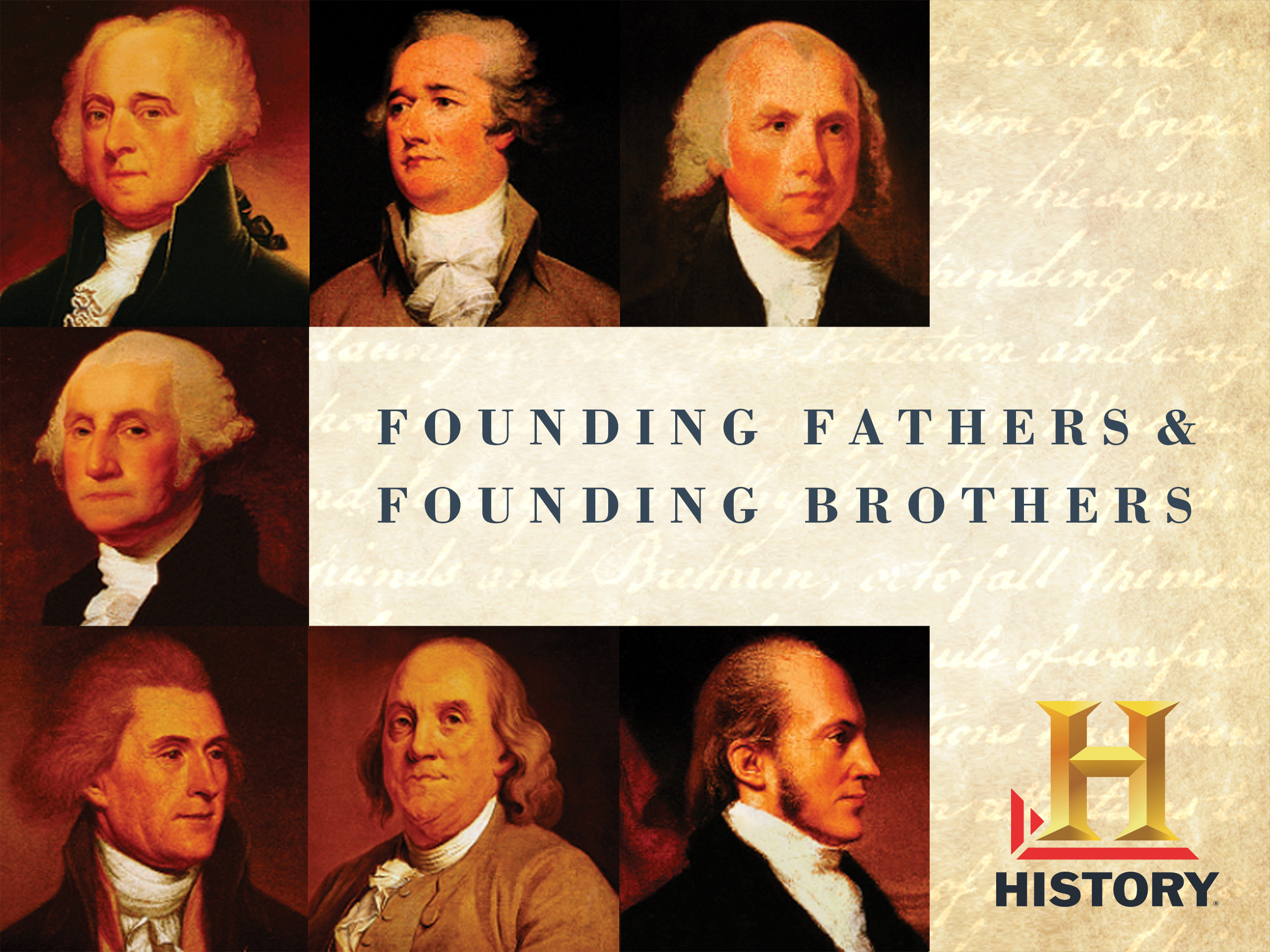
The History Channel adapted Joseph Ellis’s Pulitzer Prize-winning book, Founding Brothers, for the screen as a four-part documentary series. The documentary series consists of two main parts: A More Perfect Union and Evolution of a Revolution. They run about an hour and a half each. They are broken down further into separate hours.
“One pundit said that the American political system was created by a group of geniuses so that it could be run by a group of idiots.” – Joseph J. Ellis
Every year, I try and watching something about the American Revolution era for Independence Day. This year, I finally got around to watching Founding Brothers. I honestly can’t remember if I watched when it first aired back in 2002 but if not, it was worth the wait. I know for a fact that summer 2002 was when I first read the book because that was the summer in which I wrote a bill proposing a John Adams Memorial in my Junior Statesmen Summer School class at Northwestern University. Little did I know, Congress had given authorization for an Adams Memorial back in 2001. But to this date, much of the Adams Memorial Commission is vacant with only the four presidential appointees so far. Congress needs to appoint their eight members but I digress.
Roger Mudd host while Edward Herrmann narrates. Like any history documentary, it could easily have been one that bored its audience to tears but that’s not the case here. It keeps our attention through the entire running time, utilizing voiceovers and reenactments when necessary. I would say that it’s a solid mixture between voiceover, narration, and talking heads consisting of historians, including Ellis himself. The nice thing about documentaries is that we don’t have to worry about them taking any creative licenses to drive the plot forward or make it more interesting. The American Revolution and the country’s early years has more than enough drama in and of itself.
Much like the book, the three-and-a-half-hour documentary series focuses on the nation’s founding fathers: George Washington, Benjamin Franklin, Alexander Hamilton, Thomas Jefferson, John Adams, James Madison, and Aaron Burr. Because of his death in 1790, Benjamin Franklin is not a leading figure in the decade following the 1787 Constitutional Convention. However, one of his final acts was to speak out against slavery. While the results were not want he wanted, he made an indelible impression on others, leading President Washington to never buy another slave again.
One of the key differences between the United States at birth and Great Britain is that people did not judge American leaders by their estate but their achievements. Sure, a number of the founding brothers lived in these huge mansions, but it was not a requirement for holding office.
The program’s first hour looks at a few key items: Hamilton’s financial plan and slavery. Hamilton would not be able to get his financial plan passed without Thomas Jefferson or James Madison. Madison was Jefferson’s protege so to speak but the two were at odds with Hamilton. Their disagreements play out more during the second hour. Anyway, Hamilton wanted the central government to assume the debt by the states. Meanwhile, Jefferson’s time in France, especially during the French Revolution, would leave a lasting influence. One area in which they are at odds is Hamilton’s proposal to create a national bank.
Let’s back up for a minute. Jefferson invited both Madison and Hamilton to dinner for what would become the most meaningful dinner party in American history as it resulted in the Compromise of 1790. This gave the U.S. Capital to Virginia while Hamilton got his financial plan. It would be the last time that the trio would work together. Jefferson and Madison were on board with the assumption of state debt but not with the national bank.
There’s no denying that slavery was tearing the U.S. apart. As historian Joseph J. Ellis says, the revolutionary generation agreed that slavery was incompatible with the values of which the American Revolution was based. All the major figures were in agreement. But at the same time, slavery was embedded in societies in the South. Any attempt to end it would no doubt lead to secession. Madison was taking extensive notes during the debate. Walkouts were threatened. It was so contentious that there was not a single mention of slavery anywhere in the U.S. Constitution–listing slaves as “people” due to the Three-fifths Compromise. Meanwhile, a decision was made that the slave trade could not be abolished until 1808. Ellis views the Constitution as ambiguously designed so both North and South could claim wins.
The Pennsylvania Society for the Abolition of Slavery–the first abolitionist society and founded by the Quakers in 1775–was headed by Benjamin Franklin in early 1790. They submitted an anti-slavery petition to the First Congress. It was Franklin’s last public act because he died two months later. He became an abolitionist later in life but believed that the American Revolution was not compatible with slavery. While Congress didn’t abolish slavery, he impacted Washington in his own way. Edward Herrmann’s narration really hits home: “America’s leadership had chosen to remain silent in the greatest moral and political dilemma in United States history.”
There was much debate over what to do about the 1973 war between France and Great Britain. The U.S. decided to stay neutral, not being a superpower at the time. Both Federalists and Democratic-Republicans were in agreement over the possibility of economic disaster or invasion. There’s this idea that maybe America could have done something since France was an ally during the American Revolution. At the same time, America was young and facing its own growing pains. Jefferson decided to resign as Secretary of State in 1793, being at odds with Washington. Washington would send John Jay to England to avert war with Great Britain, resulting in the Jay Treaty in 1794. It did not play well with the Jeffersonians, later paving the way for the War of 1812. Jefferson’s publication of disparaging remarks about Washington would end their friendship.
Washington ended his administration with class. Shocking as it may be, his retirement after two terms would become the precedent for future presidents until FDR’s election to a third term. To say that there was partisan bickering in 1796 is not an understatement. Much had changed in America’s first twenty years–three more states joined the Union. Both John Adams and Thomas Jefferson would campaign to succeed the Sage of Mount Vernon. The two co-revolutionaries were friends at one time but like Washington, they, too, would become estranged. They would eventually reconcile before their July 4, 1826 deaths. But for the time being, they had to figure out how to work together with Adams as President and Jefferson as Vice President. Leaving the presidential residence together in 1797, partisan politics won out over friendship. They would not talk between 1801-1812.
While Adams and Jefferson were at odds, Adams was dealing with a cabinet loyal to not Washington but Hamilton. He had left office in 1795 but still garnered loyalty by the Federalists. Meanwhile, Hamilton has to deal with his affair with Maria Reynolds in 1797. While he was dealing with that, Adams was dealing with the threat of war with France in what would come to be known as the XYZ Affair. Adams sent a peace delegation to France. The French delegation would not deal with the American delegation unless the US bribed them. Americans were outraged as soon as the news reached the country. The Quasi-War followed in 1798. Hamilton and other war hawks were calling for a 50,000 man army. Adams relented, calling for 15,000 troops to be led by Washington. Not surprisingly, Washington’s second-in-command, Hamilton, took charge.
As the Quasi-War is going on, the Alien and Sedition Acts is passed by Congress. Jefferson and Madison secretly author the Kentucky and Virginia Resolutions. Those critical of the government ended up in prison, including sitting members of Congress. By the end of 1799, George Washington died. All of this sets the tone for 1800, pitting another campaign between Adams and Jefferson. Adams was running with Charles Pinckney while Jefferson ran with Aaron Burr. While the 12th Amendment was not ratified yet, it worked better to nominate a president and vice president on the same ticket. Burr may have been more appealing towards voters at the time but Jefferson would not select him during the 1804 election. And then there’s the fatal duel between Burr and Hamilton, which gets a significant focus in the fourth hour.
Character assassination was common in politics in the early 1800s. Jefferson utilized it to his advantage but the Federalists caught up to him. They attacked him plenty of times, even accusing him of having an affair with Sally Hemings. DNA tests have since proved an affair took place but James T. Callender went after Jefferson with the accusations when he was denied a postmaster position. Jefferson denied any relationship with Callender but this would bite him in the tuchas as Callendar kept their previous correspondence. Still though, Jefferson was for ending slavery but enslaves his own children?!? It makes no sense but it would also have an impact for Jefferson’s overall legacy. Meanwhile, Spain had ceded its territories to France. As such, Jefferson sends James Monroe to purchase New Orleans. France sold the entire Louisiana Territory for $15 million–a bargain.
The Hamilton-Burr duel is a significant moment in American history. Hamilton might not have intended to kill Burr but he wasted his shot because Burr’s shot would fatally would Hamilton. Burr could say goodbye to any political legacy or future career. He would never ever be in the room where it happened. Burr would not be tried for Hamilton’s death.
Jefferson’s second term would replace Burr with George Clinton. His first term was no doubt a success but the second term is a disaster no thanks to war between Great Britain and France. The Embargo Act of 1807 was as bad as that of the Alien and Sedition Acts. It was an economic disaster and Jefferson leaves office at a low point in 1809. At this point, Adams was retired on his farm for eight years. Neither had spoken in eight years–fellow signer Benjamin Rush would pave the way for their reconciliation. Adams sent a New Year’s greeting in 1812, the first of 158 letters to follow during the next 14 years. The letters would become fewer towards the very end of their lives but they were friends once again.
Founding Brothers changes the order of events to follow a chronological setting but the documentary is every bit the equal to the Pulitzer Prize-winning book of the same name.
DIRECTORS: Jim Milio (1×1), Mark Hufnail (1×2), Melissa Jo Peltier, Bonnie Peterson,
SCREENWRITERS: Kelly McPherson and Allison MacEwan (1×1-2), Kelly McPherson and Melissa Jo Peltier & Allison MacEwan (1×3-4)
EXECUTIVE PRODUCERS: Jim Milio, Melissa Jo Peltier, Mark Hufnail
SUPERVISING PRODUCER: Bonnie Peterson
PRODUCER: Kelly McPherson
HOST: Roger Mudd
NARRATOR: Edward Herrmann
CAST: Peter Coyote, James Woods, Brian Dennehy, Michael York, Rob Lowe, and Hal Holbrook
FEATURING: Joseph J. Ellis, Joanne Freeman, Carol Berkin, Richard Brookhiser, Gordon S. Wood, John Ferling, David McCullough, William Fowler, Joyce Appleby, Keith Arbour, Jack Rakove, Pauline Maier
Founding Brothers premiered May 27-28, 2002 on the History Channel. Grade: 5/5
Please subscribe to Solzy at the Movies on Buttondown.







